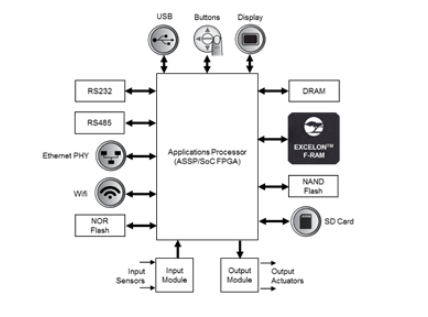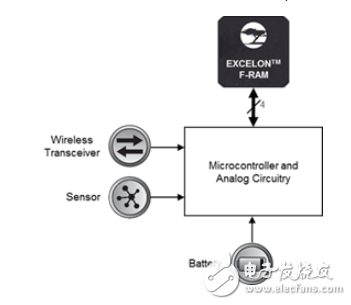Author: Vijay Ramakrishnan, Cypress
The ability to reduce downtime is an important factor in managing industrial facilities. At present, forecasting downtime is difficult and costly. For example, the downtime of an ordinary car manufacturer may be as high as $22,000 per minute or $1.3 million per hour.
With the advent of Industry 4.0, the plant's intelligence and interconnectedness are increasing. The mechanical equipment in the smart factory can use the real-time data of the connected wireless sensor nodes to predict possible faults in advance and notify the control system to take corrective measures to avoid accidental system downtime. Accumulated data can be used to improve predictive analytics and achieve better machine preventive maintenance. These advances are aimed at improving the operating efficiency of the plant and reducing overall downtime.
The foundation of Industry 4.0 - Operational data enables various functions from real-time sensing to predictive analysis. Therefore, it is important to record data continuously and reliably, especially in the event of a failure, because this data is usually the key information. In addition, the amount of data that needs to be recorded is expected to continue to increase. Not only do we need to perform continuous data acquisition on traditional industrial systems, we also need to perform continuous data acquisition on thousands of connected sensor nodes, which will be located throughout the future of smart factories.
To overcome these challenges, next-generation industrial systems require high-performance, non-volatile memory to ensure "zero data risk" and reliable data backup during normal operation and system failure. To ensure the reliability of this data record, Industry 4.0 non-volatile memory needs to support fast writes, real-time non-volatile memory, and nearly 100 trillion cycles of near-infinite read/write durability.
Industrial Data Record ChallengeIndustrial control systems include automation, energy management, process measurement, and test and measurement, all of which require high-performance, non-volatile data-logging memory. In all these market segments, non-volatile memory is used to continuously record real-time system data. They must also be able to instantly capture real-time system status data in the event of a power outage or system failure. The non-volatile data logging memory of industrial control systems and wireless sensor nodes needs to meet different needs. We will discuss the challenges and unique requirements of industrial control systems and wireless sensor nodes through two examples of programmable logic controllers and IoT sensor nodes.

Figure 1 Programmable logic controller (PLC) module diagram
Programmable logic controllers (PLCs) for industrial automation are common in industrial control systems. In a PLC, real-time system data captured by non-volatile data logging memory is used to detect and repair faults and prevent future failures. In addition, the non-volatile data logging memory captures the last system state before the power failure. This data is essential to ensure that the PLC and all connected machines restart in a safe operating mode when power is restored. Without this capability, other machines and people in the surrounding environment will face potential risks.
In next-generation industrial control systems such as PLCs, there is a need to reduce the number of microcontroller pins used to connect to external memory. This need has driven the transition from parallel to low pin count serial interface memory. This is why memory manufacturers are developing low-pin-count memories for industrial applications. For example, Cypress's Excelon-Ultra is dedicated to industrial control systems and offers a low pin count 108-MHz QSPI interface.
Due to the high reliability of removing the battery, the non-volatile memory is superior to the battery-backed SRAM generally used in industrial control systems. In addition, non-volatile memory reduces material costs by replacing a multi-component subsystem (SRAM + battery + power management controller) with a single chip and avoids maintenance associated with the costs associated with replacing batteries.

Figure 2 IOT Sensor Node Module
Wireless IoT sensor nodes are equivalent to the eyes and ears of a smart factory. As mentioned above, the sensor node can continuously monitor the system and environmental parameters and then notify the connected machine or control system to take corrective action when needed.
Wireless IoT sensor nodes present different challenges than industrial control systems. The sensor node is small in size. In addition, they are often found throughout smart factories, including remote or difficult-to-access locations. Therefore, they are usually powered by batteries or by energy harvesting.
Therefore, sensor nodes require a very small form factor non-volatile memory to continuously record real-time system data. They must be able to perform this task reliably throughout the sensor node's life cycle and minimize power consumption. For example, Cypress's Excelon-LP is available in a small 10 mm2 GQFN package and offers a variety of power saving modes, including hibernation, deep nodes, and standby, allowing developers to maximize battery life.
To further reduce the size of wireless IoT sensor nodes, non-volatile memory can be used to implement single-chip methods for code storage and data logging. In a sensor node, the code size required to measure and collect data is usually smaller than the amount of memory required to store the data. Therefore, having a separate code memory may result in insufficient memory usage, and the single-chip method may be more efficient.
The key difficulty lies in the fact that there is enough flexible non-volatile data logging memory to partition the storage of code and data according to application requirements. The memory used to store the code must ensure that the system does not accidentally write to the storage area used to execute the code. Therefore, in order to meet the requirements of the single-chip process, the non-volatile data recording memory needs to have a memory protection function. For example, block protection prevents accidental writes to a developer-defined set of addresses. This allows a memory to support real-time data logging while storing and protecting code.
Ferroelectric technology
The key to nonvolatile data logging memory is ferroelectric technology. Ferroelectric technology combines the high performance and byte addressability of RAM with non-volatile data storage. The ferroelectric technology for non-volatile memory has a memory cell using a lead zirconate titanate (PZT) film. When an electric field is applied, the central atom in the PZT crystal changes its position. The two positions of the central atom store a digit as the binary state of the memory. When the power supply is interrupted, the atomic position is preserved to protect the data. Its data reliability is also very high. It can save data for 100 years without any backup power supply.
Non-volatile data logging memory is very efficient. Its energy consumption is 200 times lower than serial EEPROM and 3,000 times lower than NOR flash. This technology also provides high data reliability with read/write durability of 100 trillion times (1014). In contrast, floating gate technologies such as flash memory and EEPROM are damaged in as short as 106 cycles, so they are not suitable for frequent system data capture.
Non-volatile data logging memory also ensures that the industrial system runs "zero data risk". Instant data storage capability protects the system from losing data when the system is powered off. Technologies such as EEPROMs typically have a 5-10 millisecond page write latency, putting system data at a significant risk for the final moment.
CAT5E Keystone Jack is an integral parts of RJ45 networking connectors for speed voice, video, data server center, CAT5E keystone jacks are an integral part of any high speed voice, data, or video network. These standardized female connectors are used for inserting multi-conductor Ethernet cable into wall plates, patch panels, or surface mount boxes. The Uonicore offer excellent value and selection with our line of keystone jacks including: MIG+, shielded, high density, tool-less, and snap-in styles
CAT5E Keystone Jack,UTP CAT5E Keystone Jack,Keystone Jack CAT5E,Cat5e Jack
NINGBO UONICORE ELECTRONICS CO., LTD , https://www.uniconmelectronics.com